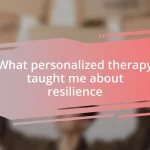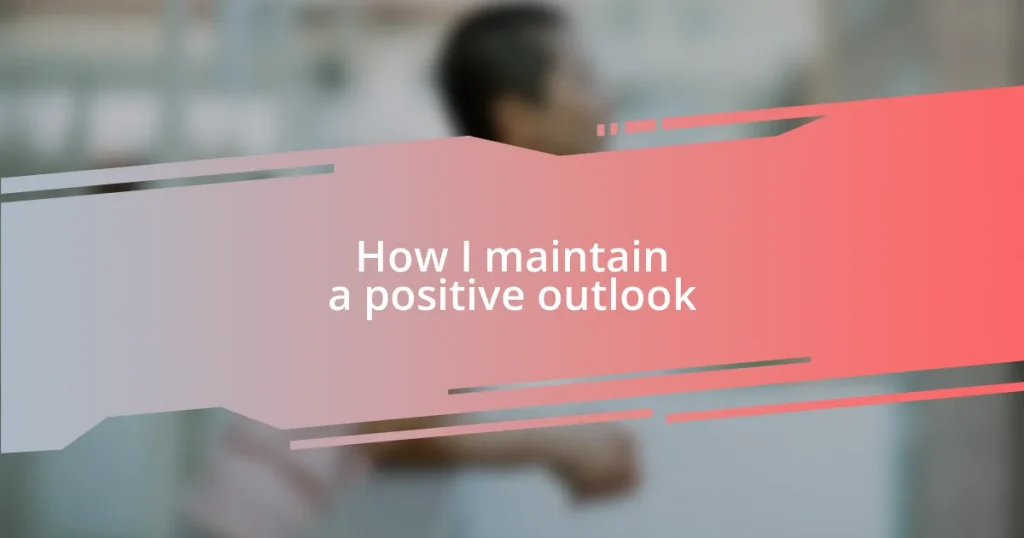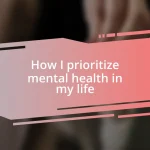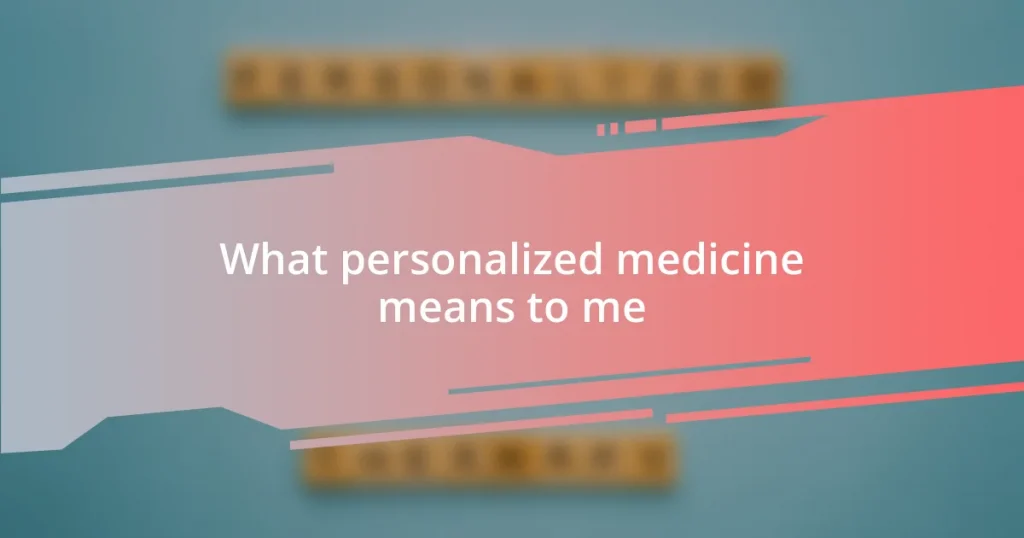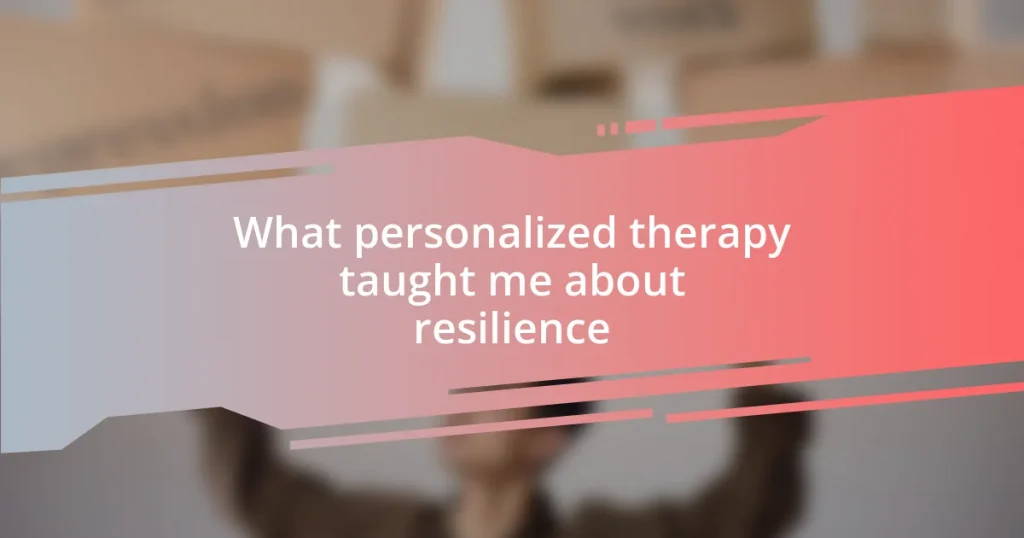Key takeaways:
- Positivity impacts well-being; focusing on small victories during challenges can lighten burdens.
- Identifying and reframing negative thought patterns, such as all-or-nothing thinking, is essential for fostering a positive mindset.
- Practicing gratitude, mindfulness, and surrounding oneself with uplifting influences creates a supportive environment that enhances positivity.
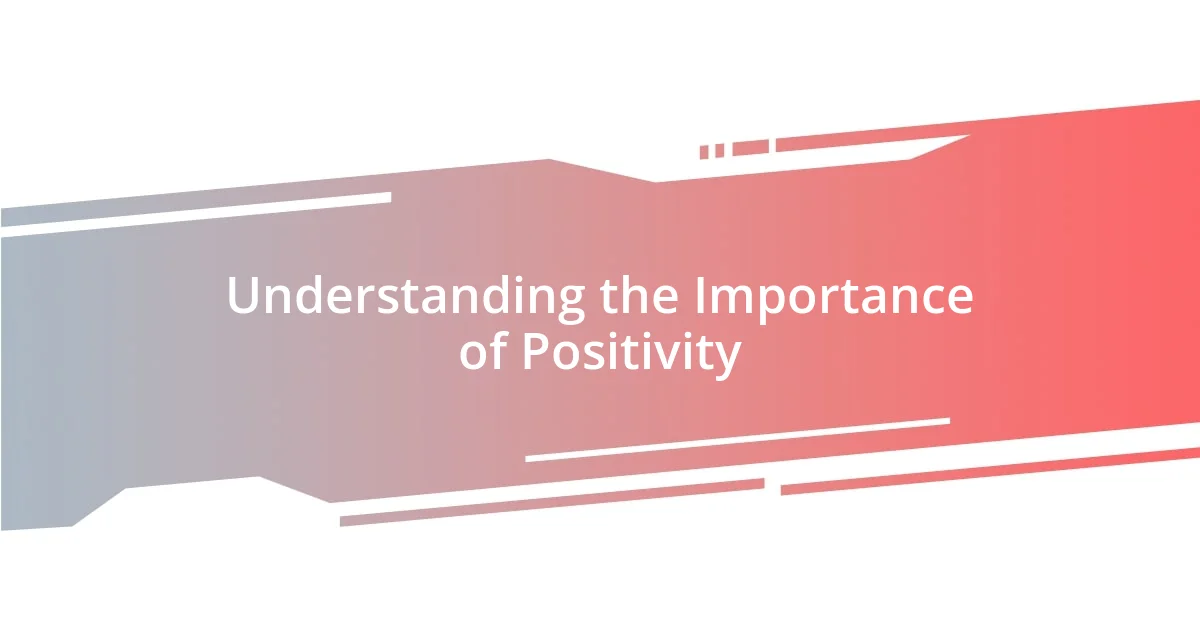
Understanding the Importance of Positivity
Positivity isn’t just a feel-good concept; it fundamentally affects our health and well-being. I recall a particularly challenging time in my life when I made a conscious effort to focus on the silver linings. Rather than dwelling on what wasn’t going right, I started to appreciate small victories, like enjoying my morning coffee or taking a walk outside. This shift didn’t erase my problems, but it certainly made them feel lighter.
Think about your daily interactions—how often do you encounter negativity? It’s exhausting, isn’t it? I often remind myself that positivity isn’t about ignoring the hard truths but instead choosing to approach them with a constructive mindset. I remember when a friend faced a significant setback and initially succumbed to despair. Yet, with a little encouragement to look for opportunities within challenges, she transformed her outlook and ultimately found a new path that led to personal growth.
The ripple effect of a positive mindset can be profound. I’ve noticed that when I maintain a positive stance, friends and family tend to mirror that energy. It’s fascinating how a simple smile or a kind word can uplift not just my mood but also those around me. Isn’t it incredible to think that our attitudes can influence the atmosphere of our surroundings? We’ve all felt that electric connection when someone radiates genuine positivity—it’s contagious!
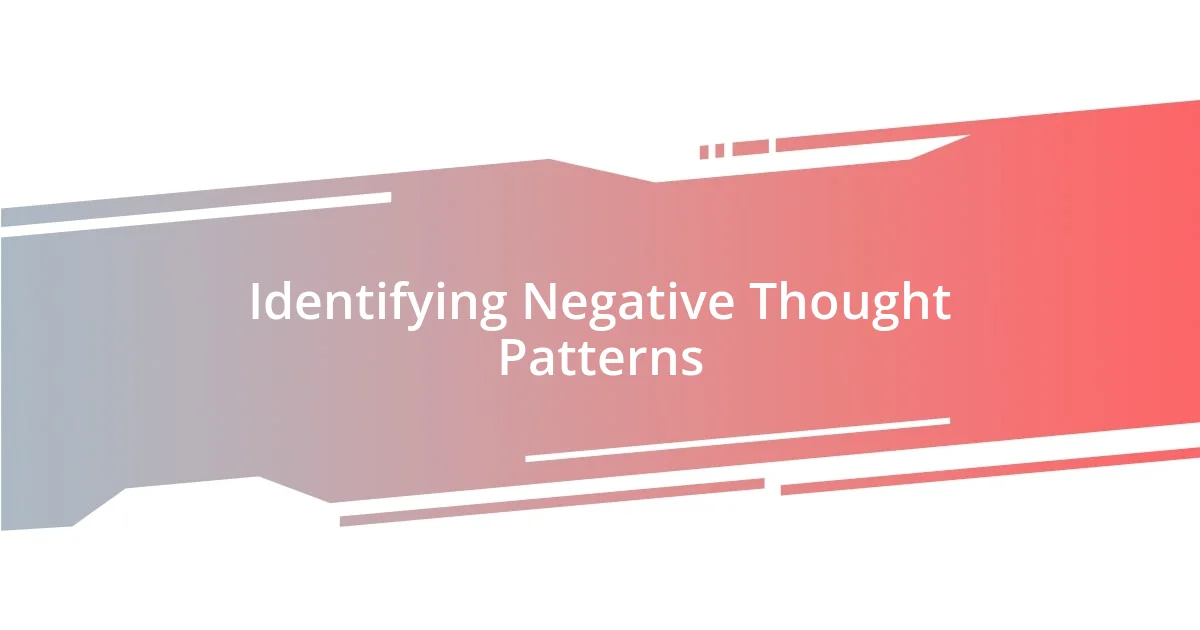
Identifying Negative Thought Patterns
Identifying negative thought patterns is crucial for fostering a more positive outlook. I’ve noticed that these patterns often creep in subtly, almost like an uninvited guest. For example, when I faced setbacks at work, I found myself caught in a loop of self-doubt, thinking phrases like “I’m not good enough” or “I’ll never succeed.” Recognizing that these thoughts were merely reflections of my fears, rather than facts, helped me break free from the cycle.
Here are some common negative thought patterns to watch for:
- All-or-Nothing Thinking: Viewing situations in black-and-white terms, like believing you must be perfect or you’re a failure.
- Overgeneralization: Taking one negative experience and assuming it will affect all future results.
- Catastrophizing: Expecting the worst possible outcome in every scenario, no matter how unlikely.
- Self-Criticism: Engaging in harsh self-judgments that undermine your confidence.
- Discounting the Positive: Ignoring or minimizing your achievements and focusing solely on your shortcomings.
These patterns may feel familiar; I’ve certainly wrestled with them. By bringing awareness to these thoughts, I started to see them not as truths, but as temporary clouds passing through my mind.
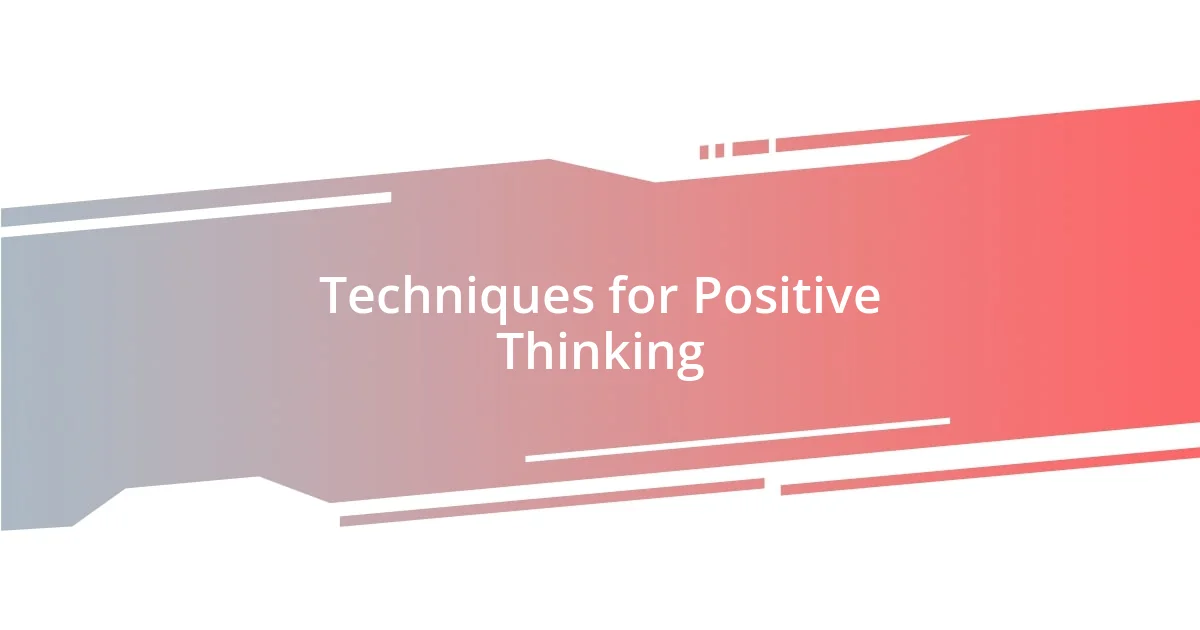
Techniques for Positive Thinking
To cultivate a positive mindset, I’ve found various techniques that can work wonders. One powerful method is practicing gratitude. Each evening, I jot down three things that brought me joy that day, no matter how small. This simple act shifts my focus from what’s lacking to what’s abundant in my life. It’s amazing how quickly my mood elevates when I recognize the blessings around me, like a cozy dinner with loved ones or a productive workday.
Another technique I incorporate is mindfulness meditation. This practice has allowed me to pause and observe my thoughts without judgment. I remember when I first started, it felt challenging to quiet my mind, but now it feels like a sanctuary. Investing just a few minutes a day can create a significant impact. Over time, I’ve noticed I’m much more present, reducing anxiety about the future and regrets from the past.
Lastly, surrounding myself with positive influences has been a game changer. I deliberately choose to spend time with individuals who uplift and inspire me. One friend, in particular, has a remarkable way of viewing challenges as adventures. Whenever we chat, I leave feeling empowered and ready to tackle anything life throws my way. Engaging with positivity breeds positivity, and it’s a beautiful cycle!
| Technique | Description |
|---|---|
| Gratitude Journaling | Writing down three positive things each day boosts my mood and shifts my focus. |
| Mindfulness Meditation | This practice helps me observe my thoughts without judgment, promoting presence and reducing anxiety. |
| Positive Influences | Surrounding myself with uplifting individuals empowers me and fosters a supportive environment. |
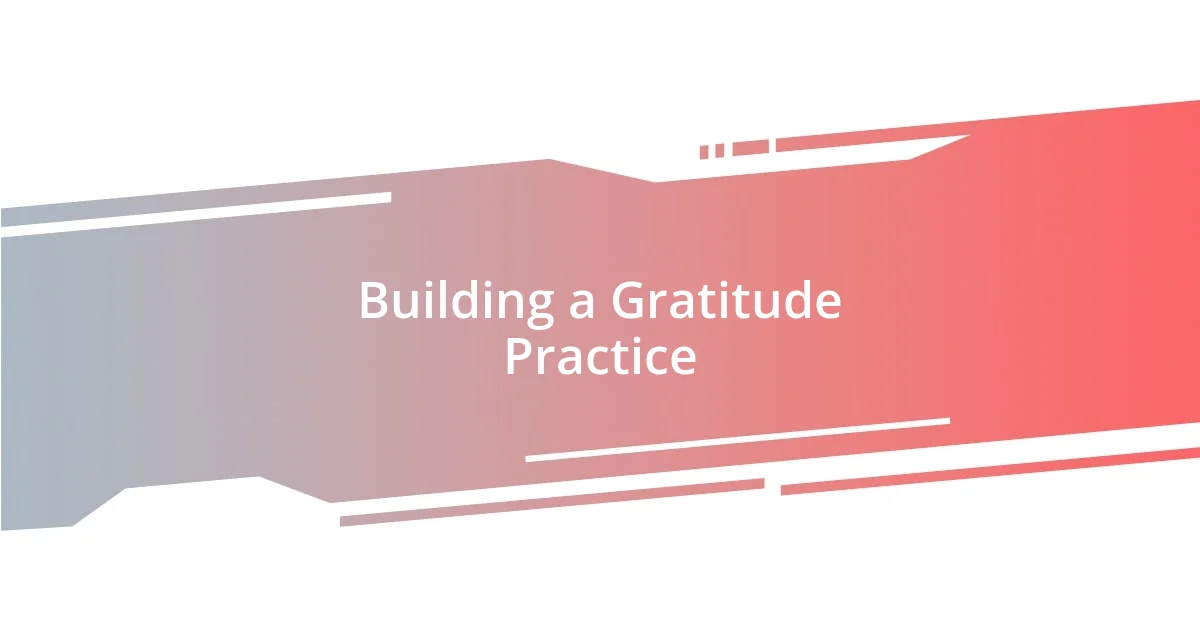
Building a Gratitude Practice
Building a gratitude practice has been a transformative journey for me. I remember the first time I committed to writing down things I was grateful for. It felt a bit forced at first, like I was trying to force a smile when I was still feeling gloomy. But, as I continued over the weeks, I found myself genuinely looking forward to this nightly ritual. It’s almost like my brain recalibrated to notice the little flickers of joy throughout the day, whether it was a friendly smile from a stranger or the comfort of curling up with a good book.
There are days when it’s tough to find things to be thankful for, especially during challenging times. I’ve learned to dig a little deeper on those days. Instead of focusing only on the big wins, I might jot down something as simple as the aroma of my morning coffee or the warmth of the sun on my face. Isn’t it fascinating how the small moments can sometimes offer the greatest comfort? This shift in perspective has taught me that gratitude isn’t just a checklist; it’s a way of seeing the world that nurtures resilience and hope.
Incorporating this practice into my life has not only lifted my spirits, but it’s also altered how I view my challenges. For instance, when facing a tough day at work, I pause and remind myself of what I’m grateful for about that job—like the supportive colleagues or opportunities to learn and grow. Whenever I reflect on those positive elements, I can tackle difficulties with a newfound sense of strength. Have you noticed how gratitude has the power to transform how you approach your day? It’s a tool we all have access to, and when we embrace it, life feels a little brighter.
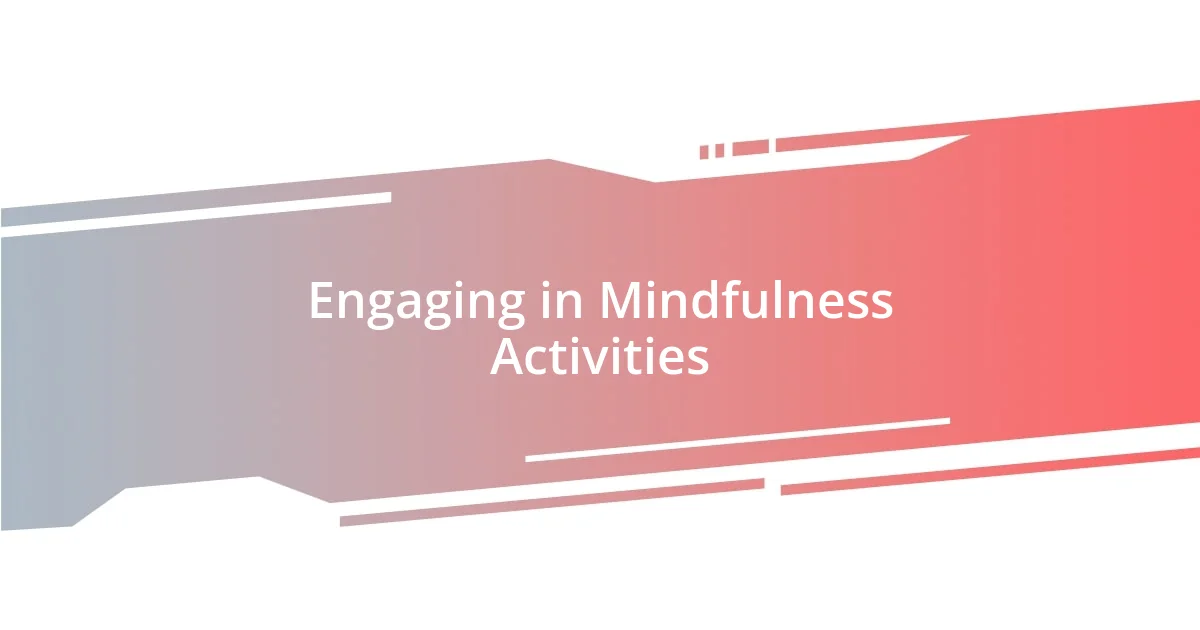
Engaging in Mindfulness Activities
Engaging in mindfulness activities has fundamentally shifted how I navigate daily life. For instance, I often take short walks in nature, focusing on my surroundings instead of letting my mind race with to-do lists. There’s something profoundly calming about listening to the rustle of leaves or the gentle flow of water; it anchors me in the present. Have you ever stepped outside and felt all your worries fade away? There’s a magic in those moments that’s hard to replicate.
One practice I’ve found incredibly beneficial is mindful breathing. During my lunch breaks, I set aside five minutes to breathe deeply, inhaling slowly through my nose and exhaling through my mouth. It sounds simple, but the way it resets my thoughts is profound. I remember a particularly stressful week when my mind was a whirlwind of uncertainties. Just those few quiet moments helped me regain focus and clarity. I couldn’t believe how quickly I transitioned from feeling overwhelmed to feeling centered. Isn’t it amazing how something so fundamental can have such a significant effect?
Of course, mindfulness isn’t just about formal practices; it can also be woven into mundane tasks. During my evening dishes, I try to focus entirely on the sensation of warm water and the light clinking of glassware. Initially, I caught my mind drifting to everything except what I was doing. But as I practiced, I began to savor those little moments, realizing how often I rush through life. It’s a gentle reminder that mindfulness can be found in the ordinary, and sometimes, it’s in those everyday experiences that we find the most profound peace. Can you recall a time when being fully present made a difference in your day? I find that these tiny shifts in awareness can create big changes in how we feel.
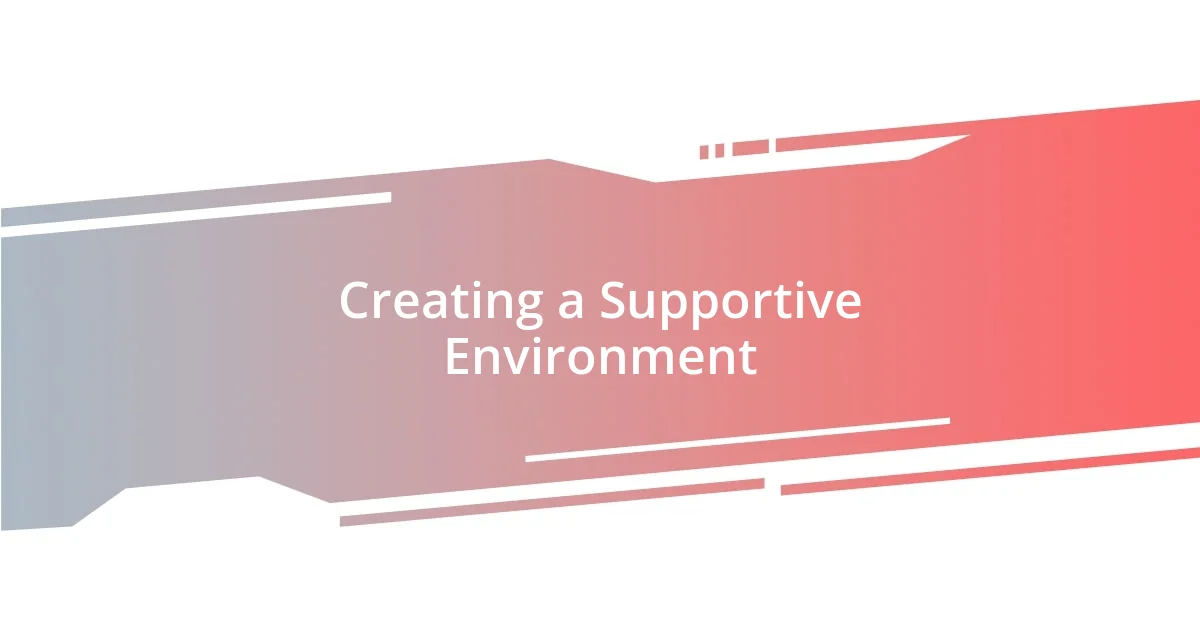
Creating a Supportive Environment
Creating a supportive environment is crucial for maintaining a positive outlook. I remember when I consciously decided to surround myself with people who uplifted me. There was a moment when I realized how draining it was to be around negativity. In contrast, having friends who share inspiring stories and engaging conversations makes me feel energized and motivated. It’s incredible how the right company can spark joy and encourage optimism.
One of the most powerful shifts I made was to curate my digital space as well. Believe it or not, unfollowing certain accounts on social media—those that spread negativity or unrealistic comparisons—was liberating. Instead, I started following content that inspires and educates, filling my feed with positivity. Have you considered how your digital environment influences your mood? For me, it felt like taking a deep breath after swimming in murky water; everything became clearer and lighter.
Additionally, when I think about physical space, keeping my home organized and filled with items that bring me joy has been game-changing. There was a period when clutter overwhelmed me, clouding my thoughts and making me feel restless. I dedicated a weekend to decluttering, and as I cleared out old belongings that no longer served me, I felt a wave of freedom. The simple act of surrounding myself with meaningful objects created a sanctuary where I could recharge. How does your space affect your mental landscape? I find that a supportive environment isn’t just about people; it’s also the energy we cultivate around ourselves.
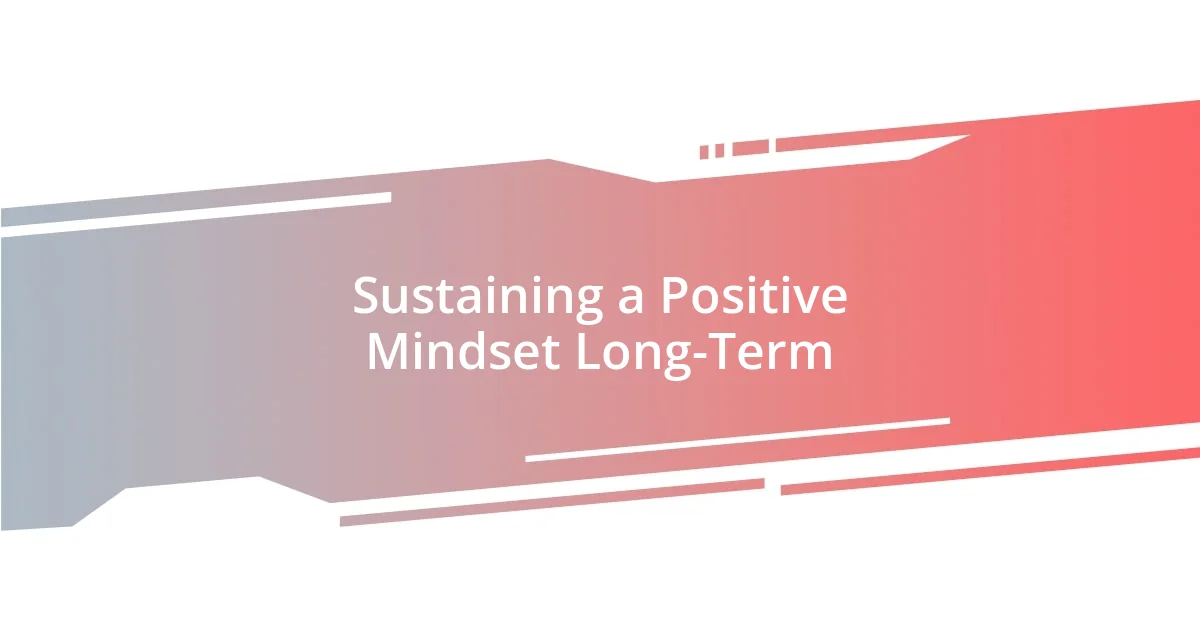
Sustaining a Positive Mindset Long-Term
Sustaining a positive mindset long-term requires ongoing commitment and self-reflection. I’ve noticed that integrating gratitude practices into my daily routine works wonders for my overall outlook. Each night, I jot down three things I’m grateful for—some days they’re monumental, and other days they’re as simple as a warm cup of tea. It’s those small moments that often remind me of the beauty in life, serving as gentle reminders to focus on what enriches my experience.
Another technique I’ve found effective is setting personal intentions each morning. I like to pause for a minute and think about how I want to feel throughout the day. It might be a word like “calm” or “connected.” This brief moment of intention-setting shapes my mindset, creating a subtle but powerful shift in how I approach the hours ahead. Have you ever considered the impact of your daily intentions? In my experience, this practice can be a game-changer, steering my thoughts to more constructive pathways.
Moreover, I’ve discovered how beneficial it is to embrace change when it arises. There was a time when unexpected events knocked me off my feet, leaving me overwhelmed. By learning to view these moments as opportunities for growth rather than setbacks, I’ve cultivated resilience. It’s about reframing challenges and understanding that each one can teach us something valuable. How do you respond to life’s twists? Recognizing that every situation carries potential growth allows me to maintain a more optimistic perspective, even during tough times.


